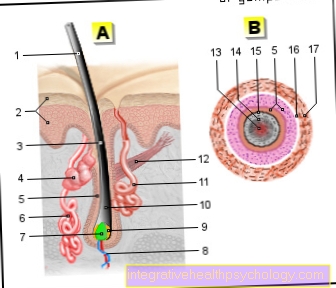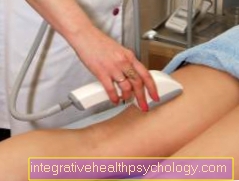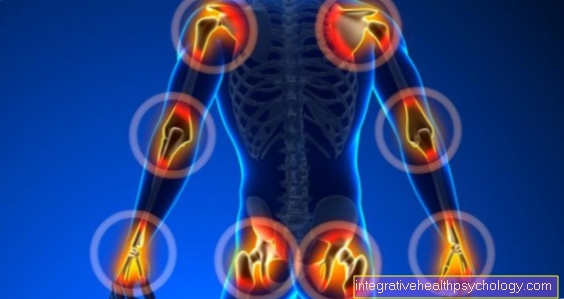Hair loss from a thyroid disorder
introduction
To begin with, hair loss is a very common thing. Everyone loses some hair every day, hair loss is a natural reaction of the body, especially in older men.
In principle, however, you should not lose more than 100 hairs per day. In contrast, those who lose significantly more hair suffer from hair loss.
The thyroid disorder is divided into two opposing diseases: A distinction is made between hyperthyroidism (overactive thyroid) and hypothyroidism (underactive). Both thyroid disorders can lead to hair loss by changing the hormones.

causes
The causes of hair loss due to a thyroid disorder can lie in both overactive and underactive thyroid.
When the thyroid gland is overactive (hyperthyroidism), the organ produces too many of its hormones. Among other things, this disrupts the growth of the hair so that it can fall out.
The underactive thyroid (hypothyroidism), on the other hand, has more of an effect on the structure of the hair. These become dull and dry from the lack of thyroid hormones, causing them to break off and fall out quickly.
Hyperthyroidism
With hyperthyroidism, hair loss is one of the many typical symptoms. The hyperfunction can be triggered by various factors.
Often times, hyperthyroidism arises due to inflammatory or autoimmune processes in the body. The immune system begins to recognize the thyroid gland as a foreign body. In return, the thyroid gland produces more hormones.
Malignant diseases are also rarely the reason for an overactive thyroid. If, for example, a hormone-producing tumor develops in the thyroid gland, the secretion of thyroid hormones suddenly increases significantly.
In addition, the so-called iatrogenic cause of the overactive thyroid cannot be ruled out. This is a hyperthyroidism caused by humans (mostly treating doctors) through too high a dose of thyroid hormones. Even people with an underactive thyroid can have too many thyroid hormones in their blood if they overdose on their medication.
If the pituitary gland (pituitary gland) is overactive, an overactive thyroid can occur. There the hormone TSH is produced, which in turn stimulates the thyroid gland to produce its hormones T3 (triiodothyronine) and T4 (thyroxine).
The hormones T3 and T4, in turn, increase the body's overall metabolic rate, and the new formation of various substances that are necessary for hair growth is inhibited.
Read more about hyperthyroidism at: Hyperthyroidism
Hypothyroidism
The underactive thyroid gland (hypothyroidism) does not usually have a direct effect on the growth of hair, so hair loss is a rather rare symptom of hypothyroidism.
An underactive thyroid can be triggered by various factors. The function of the thyroid gland is very rarely disturbed in the newborn, in which case the thyroid gland is not fully developed, so that hardly any thyroid hormones are formed. In addition to many other symptoms, this means that newborns do not lose their first hair and no new hair is formed.
In old age, the hypothyroidism is due to various factors. A lack of iodine and selenium is often the cause of hypofunction. Without these elements, the thyroid is only able to perform to a limited extent; the secretion of thyroid hormones is significantly reduced.
Autoimmune processes also play a role in hypothyroidism. For example, inflammatory processes can be triggered that have a negative effect on the function of the thyroid gland. Hashimoto's disease also triggers an underactive thyroid. In principle, hypothyroidism can also be triggered by operations on the thyroid gland.
In addition, a disease of the pituitary gland (pituitary gland) can affect the thyroid gland. If too little TSH hormone is produced in the pituitary gland, the thyroid gland does not receive enough stimulus to produce its hormones.
Hypothyroidism manifests itself in a deficiency of the thyroid hormones T3 and T4. This lowers the body's metabolic performance. On the hair, this leads to brittle and dry hair, which promotes hair loss.
You can find more information on hypothyroidism here: Hypothyroidism
Hashimoto
Hashimoto's disease (Hashimoto's thyroiditis) is an autoimmune disease of the thyroid gland. In autoimmune diseases, cells of the immune system attack the body's own organs; in the case of Hashimoto's, the thyroid is affected. The exact causes of the disease have not yet been clarified, but it is a common disease.
First of all, Hashimoto can be accompanied by a short-term hyperthyroidism, which can disrupt hair growth due to an excess of hormones. In the long run, however, an underactive thyroid develops. This makes the hair particularly brittle and can cause hair loss. Hashimoto's thyroiditis is currently not curable, but the symptoms can be treated very well by administering thyroid hormones.
Do you have Hashimoto's thyroiditis? Read more about this at: Hashimoto's thyroiditis
diagnosis
The diagnosis of thyroid dysfunction should begin with a detailed anamnesis. The doctor uses specific questions to determine which complaints the person concerned has. Based on the various symptoms, initial indications of whether the thyroid is over- or under-active.
In order to speak of hair loss due to thyroid dysfunction, the criterion of hair loss with over 100 hairs a day must also be met. The thyroid can then be examined by touching and listening; an enlargement of the thyroid, lumps and increased blood flow can be noticed. To confirm the diagnosis of the dysfunction, a blood test is carried out and changes in the thyroid hormones TSH, T3 and T4 are found.
You can read more information on this topic in the next article: Blood test
How can you be sure that the hair loss is caused by the thyroid gland?
Whether the hair loss is caused by the thyroid dysfunction cannot be determined with absolute certainty. However, the more other symptoms of the dysfunction and the fewer other causes of the hair loss, the more likely it is. Hormonal changes often play a role in symptoms such as hair loss, so you should first clarify whether other hormones are present in changed concentrations in addition to the thyroid gland. In men in particular, it is difficult to distinguish it from natural hair loss. The surest method of detection is when hair loss decreases or stops after thyroid dysfunction therapy is started.
Other symptoms of a thyroid disorder
In the case of thyroid dysfunction, a fundamental distinction must be made between overactive and underactive. Since there are two opposing clinical pictures, the accompanying symptoms are also very different.
An overactive thyroid (hyperthyroidism) strongly stimulates the body's metabolism. This can lead to severe weight loss, cravings, nervousness, and insomnia. The cardiovascular system is also influenced by the excess of thyroid hormones, so there is both higher blood pressures and an increase in the heart rate up to abnormally fast heartbeats. In addition, so-called heat symptoms occur in particular. There is profuse sweating and, as a result, damp skin. In addition, affected people do not like to be in the warm, but prefer the cold.
Hypothyroidism, on the other hand, has many opposing symptoms.This leads to cold intolerance and increased freezing as well as loss of appetite and possibly weight gain. Typically, the skin becomes very dry. General symptoms such as fatigue, poor performance and poor concentration can also be the expression for hypothyroidism. In addition, the digestive tract is often influenced by the thyroid gland, which means that the underactive thyroid causes more constipation.
One of the few symptoms that both thyroid disorders have in common is hair loss, but it is caused by different mechanisms.
sweat
Sweating is a typical symptom of an overactive thyroid. The overproduction of thyroid hormones strongly activates the body's metabolism. The body consumes a lot of energy and therefore produces a lot of heat.
In order not to overheat, the body starts its simplest cooling mechanism: sweating. The moisture that forms on the skin when you sweat evaporates in the air and thus draws energy (= heat) from the skin. So the body can cool down again.
With hypothyroidism, on the other hand, there is often a particularly increased sensation of cold, so affected people sweat significantly less than usual.
treatment
The therapy of hair loss in the case of thyroid dysfunction consists in adjusting the thyroid hormones. Depending on whether you are over- or under-functioning, you have to resort to different therapeutic mechanisms.
In most cases, hypothyroidism is treated by substituting thyroid hormones. Once normal hormone levels are reached, symptoms usually improve within a short period of time. However, it often takes a certain amount of time before the correct setting is made. In difficult cases one must expect a hormone setting of up to a year.
The therapy for hyperthyroidism, on the other hand, must be selected depending on the triggering cause. If the thyroid gland itself produces too many hormones, the dysfunction can be treated with medication, these are called anti-thyroid drugs.
If thyroid function remains increased despite the anti-thyroid drug, surgery on the thyroid gland should be considered. Partial or complete removal of the thyroid can be performed.
A so-called goiter resection is necessary, especially if the thyroid gland is enlarged (goiter), although part of the thyroid gland can be preserved.
If a tumor is the cause of the hyperthyroidism, a complete removal (thyroidectomy) must be performed.
Duration of hair loss
How long the symptom of hair loss in thyroid dysfunction lasts depends primarily on how long it takes to develop what is known as euthyroidism. This term describes a condition in which neither too many nor too few thyroid hormones are present.
Since the function of the thyroid gland is subject to a complex control loop, a good adjustment of the function can take up to a year. However, the hair loss usually improves a few weeks after the thyroid therapy has started.
forecast
In the event of hair loss due to a thyroid dysfunction, the hair can grow back. If the thyroid gland is well adjusted, the factors that disrupt hair growth or make hair brittle are no longer present. This allows the hair to partially regenerate. Often, however, new hair has to grow back first, so it takes a while before the original hair situation is restored.


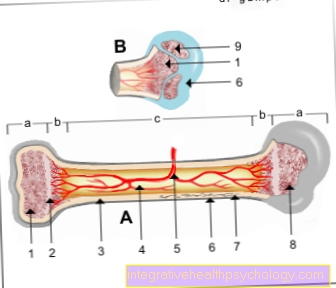

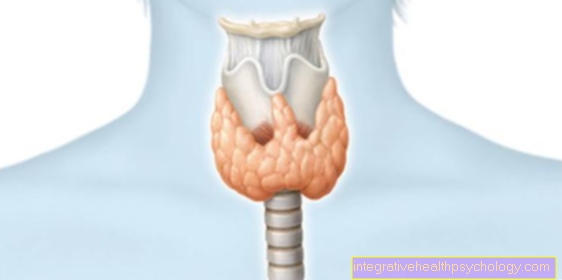

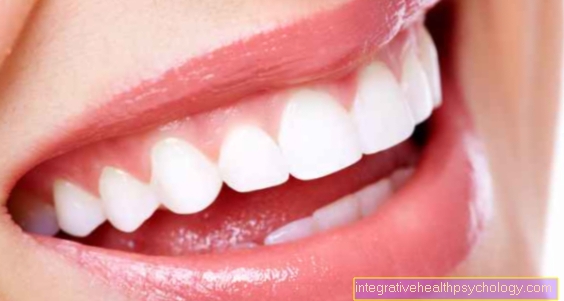
.jpg)
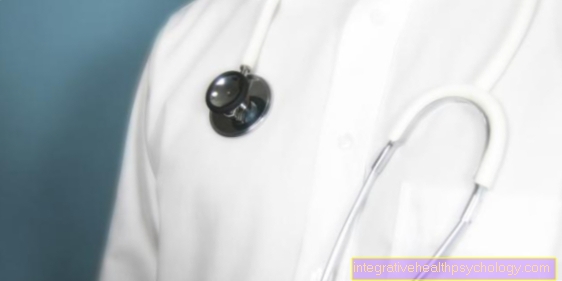



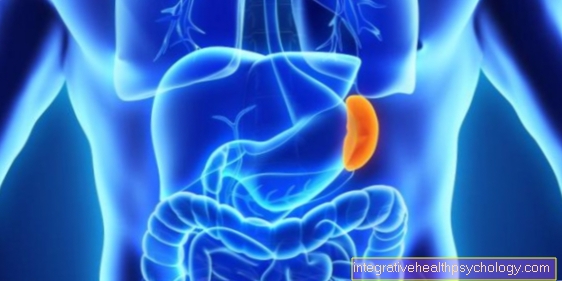

.jpg)






